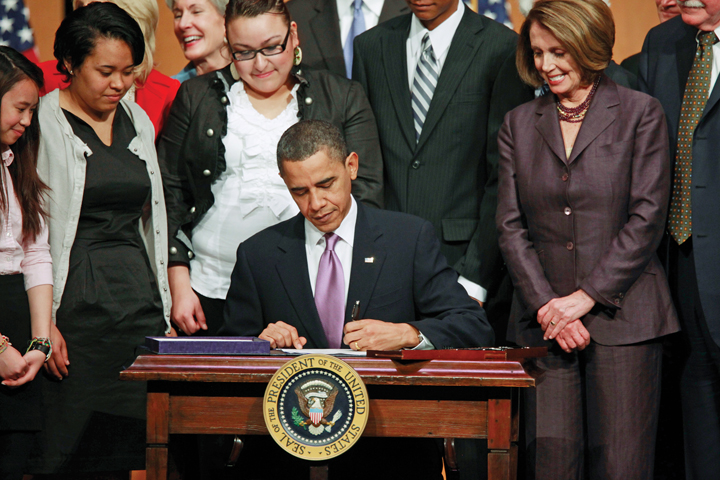University health insurance rate increase expected
Promising decreased costs, President Obama signed sweeping health care legislation into law.
It is unclear what the effect of the health care reform bill will be on the already-high premiums at St. Edward’s University, but the Human Resources department is bracing for an increase.
Human Resources Director Haven Street-Allen said that the university’s health insurance plan, which covers 600 St. Edward’s employees, could be in danger of being taxed when many of the provisions of the health care plan go into effect. The bill will tax health insurance plans of more than $8,500 for individuals and $23,000 for family plans.
Currently, St. Edward’s most popular plan, Aetna HMO, costs $5,802 for employees and $17,136 for families.
“We would hope this wouldn’t be a problem, but there are provisions in the law which will result in increases in premiums,” Street-Allen said, adding that she would not be surprised by a 25-35 percent insurance premium rate increase next year.
These provisions include a 2011 requirement for insurance companies to fully cover preventative procedures and the elimination of maximum annual benefits such as a maximum annual benefit for durable medical equipment and maximum lifetime benefits. Health insurance companies are expected to pass on the cost of covering these procedures to consumers in the form of higher premiums.
St. Edward’s changed its insurance plan in 2008 when its former provider, Humana, asked for a 54 percent premium increase, forcing Human Resources to negotiate for a lower-cost plan. However, Street-Allen said premium increases usually vary from 5-20 percent annually, but added that a few very ill employees could lead to a more drastic increase in premiums.
“Most of our employees share in the cost of coverage so premium increases impact them directly,” Street-Allen said. “Employees who have higher out-of-pocket medical costs are impacted when benefits decrease. In group insurance, it is a constant balancing act to try to do what is best for most people most of the time.”
An annual 20 percent increase in health insurance costs would put the St. Edward’s health insurance premiums over the $23,000 threshold by 2014, leading to even higher costs. Street-Allen said there is no way of predicting what the costs would be or what St. Edward’s would do if the premiums became taxable.
But Street-Allen said she was most disappointed in the decreased upper limit in Flexible Spending Accounts, also known as health savings accounts, which are separate from health insurance plans. Through Human Resources, employees contribute a portion of their earnings to an account, which pays for the cost of medical procedures that are uncovered by health insurance plans.
The health care bill lowers the tax-deductible amount of money an employee can contribute from $2,500 to $5,000. There are currently 300 faculty and staff members on the FSA plan.”I use mine to cover prescription co-pays, dental expenses not covered under my dental plan, eyeglasses in excess of what my vision benefit provides and even over-the-counter medications if my doctor prescribes them,” Street-Allen said. “This reduction will actually impact those with higher medical expenses, increasing the cost to those who have some of the highest expenses.”
Last month, the Associated Press reported White House officials as saying that employers would see premiums fall by $3,000. Lawmakers are aiming to control costs by reducing some medical compensation, increasing preventative care and a reduction in uncompensated emergency room visits. The point of mandating individuals to obtain health insurance, especially healthy young adults, is also an attempt to spread costs more evenly, said Brian Smith, assistant professor of political science.
Smith and Street-Allen said that much of the results of the bill are still unknown. But he said he believes the bill will likely cut down on health care costs by reducing emergency room visits by the uninsured, who will be more likely to visit a primary care physician instead.
“For some people, health care costs may go down,” Smith said. “For people in my position, I would expect to see what we see every year.”
Smith said that he does not believe much of the health care bill will not affect the already-insured.
“One of the problems is that we are already covered,” Smith said. “We aren’t going to see any real direct benefits.”
In Massachusetts, where a very similar plan was implemented in 2006, the cost of health insurance premiums have still increased 40 percent, which is 7 percent more than the increase of costs nationwide, according to a report published in the Boston Globe.
“I think insurance companies are scared. I think health care providers are scared,” Street-Allen said. “Both of those facts lead me to believe that the actual charges from health care providers will increase, possibly at a greater rate than in the past, and insurance companies will be trying to cover anticipated losses between government mandates and a greater trend.”
But Smith said that, personally, he does not believe the bill will have much of an impact on his health insurance plan.
“I’ve never seen my health insurance decrease,” Smith said. “Anyone who thinks that they are going to get free health care out of it, or that they are going to get their bills reduced, doesn’t know what this bill is about.”






